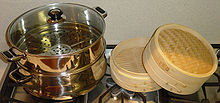Steaming

Steaming works by boiling water continuously, causing it to vaporize into steam; the steam then carries heat to the nearby food, thus cooking the food. The food is kept separate from the boiling water but has direct contact with the steam, resulting in a moist texture to the food. This differs from double boiling, in which contact with steam is undesired. Such cooking is most often done by placing the food into a steamer, which is typically a circular container made of metal or bamboo. The steamer usually has a lid that is placed on the top of the container during cooking to allow the steam to cook the food. When a steamer is unavailable, a wok filled less than half with water is a replacement by placing a metal frame made of stainless steel in the middle of the wok. Some modern home microwave ovens include the structure to cook food by steam vapor produced in a separate water container, providing a similar result to being cooked by fire. [edit]Benefits Overcooking or burning food is easily avoided when steaming it. Individuals looking to reduce their fat intake may prefer steaming to other methods which require cooking oil. Steaming also results in a more nutritious food than boiling because fewer nutrients are leached away into the water, which is usually discarded. A 2007 USDA comparison between steaming and boiling vegetables shows the most affected nutrients are folic acid and vitamin C. When compared to raw consumption, steaming reduces folic acid by 15%, and boiling reduces it by 35%. Steaming reduces vitamin C by 15%, and boiling reduces it by 25%. Phenolic compounds with antioxidant properties have been found to retain significantly better through steaming than through boiling or microwaving.[1] Most other nutrients are reduced by a similar amount by both methods of cooking.[2] [edit]Food by steaming In China, the Chinese have used steamers for at least 3000 years or more, with early steamers being made in stoneware and originating in the province of Yunnan. From the eighth century, thin cypress strips were used to make steamers and today they are constructed from bamboo with slatted bases. In Western cooking, steaming is most often used to cook vegetables - it is rarely used to cook meats. In Chinese cuisine, vegetables are mostly stir fried or blanched and seldom steamed. Seafood and meat dishes are steamed. For example: steamed whole fish, steamed crab, steamed pork spare ribs, steamed ground pork or beef, steamed chicken, steamed goose, etc. Other than meat dishes, rice can be steamed too, although in Chinese this is rarely referred to as "steaming" but rather simply as "cooking." Wheat foods are steamed as well. Examples include buns, Chinese steamed cakes etc. Steamed meat dishes (except fish and some dim sum) are less common in Chinese restaurants than in traditional home cooking because meats usually require longer cooking times to steam than to stir fry. Commercially sold frozen foods (such as dim sum) used to have instructions to reheat by steaming, until the rise in popularity of home microwave ovens which have considerably shorter cooking times. The classic steamer contains a chimney through the center, which distributes the steam among the tiers.